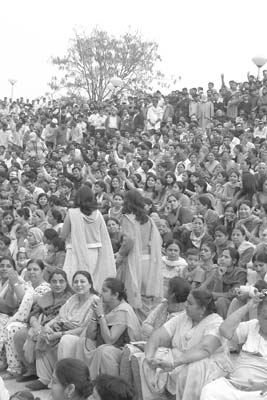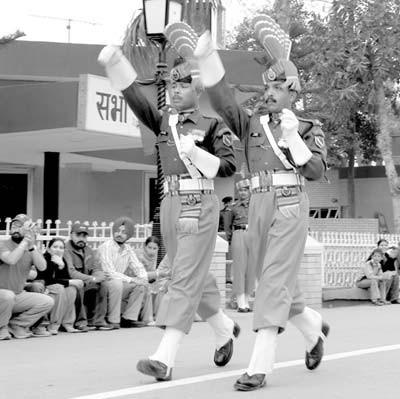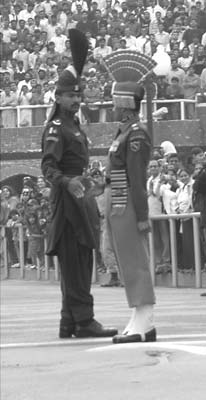India/Pakistan border ceremony
For pure pageantry and nationalistic bravado, visit the border post ceremony in Wagah, a town half in India and half in Pakistan, at sunrise or sunset. This is the only road crossing between the two countries, and twice daily crowds gather to witness the ceremonial opening or closing of the border.
My husband, Clyde, and I attended the ceremony on Feb. 26, 2007. We flew to Amritsar from Delhi that afternoon, checked into our hotel, the CJ International (July ’07, pg. 62), and still had time to be driven the 30 kilometers to the border. Traffic in India always is heavy and I recall it took about an hour to get there.
It was just a week after the Attari Express train bombing in Panipat. I was a bit nervous about safety issues but still wanted to see the event. Before we left Delhi, a friend there reminded me that bad things can happen anywhere, anytime. True enough, but I did worry that we might be putting ourselves in harm’s way. Needless to say, we were fine.
Once parked, we followed the crowds walking on the approach road. Security was tight, and we had to park about five minutes’ walk from the border, then pass several armed soldiers at checkpoints (though without any frisking of body or handbag).
According to the literature, about 5,000 Indians show up daily to watch this event. The closer we got to the border, the more festive the atmosphere became. Thousands of men and women were seated on concrete bleachers, and more Indians were arriving as we wandered around. Uniformed soldiers in bizarre hats were scattered about.
In the roadway in front of the stands were at least a hundred youthful, rowdy, fervently patriotic young men noisily demonstrating, singing and cavorting. They were herded back to the stands before the proceedings began. People were excited but well behaved.
Our airport meet-and-greet, provided by Swagatam Tours & Travels in Delhi (who also provided the car and driver), told us that we should go to the VIP seating at the ceremony, but he had not specifically said where it was. We climbed to the top of the bleachers for an overview, took some photos from there and then walked down to the road toward the border gate itself where we saw people sitting on the curb.
A young man who later turned out to be the “cheerleader” directed us toward the curb very near the gate, telling us that that was the VIP seating where we should go. It certainly provided an unobstructed view of all the pageantry, although the curb soon proved uncomfortably hard, plus it was an awkward angle from which to take photographs.
Having a non-Indian face probably will allow you access to this area if you just look like you know where you are going. A kind Indian (VIP?) gentleman sitting on the curb invited us to share his space. When I stood to take a photo and others tried to sit at my place, my new friend shooed them away. More important Indian dignitaries were sitting at tables with umbrellas on a grassy area behind our curb.
We could see into Pakistan through the sometimes-open gate or over the fence. A similar crowd of about 5,000 Pakistanis sat in bleachers that looked a little newer and a little fancier.
Just before sunset, the perfectly orchestrated event began. The call of the “cheerleader” was followed by the crowd’s loudly chanting in response. For a time, each side let the other chant uninterrupted — amazingly polite behavior by two sides who are not the best of friends, to say the least.
I had no idea what our group was shouting, but my seatmate translated it as having something to do with “Mother India forever.” The Pakistanis obviously were shouting something entirely different.
Soon the chanting was followed by soldiers on each side parading toward the gate, first the Indians in their modern khaki uniforms, then the Pakistanis in their historical black uniforms, both sides with preposterous headgear. The goose-stepping, the quick-marching, the flag lowering, the horn playing, the fist waving, the gate opening, the gate shutting: all added to the drama of the event.
Considering that these are two armies which profess to be mortal enemies and barely communicate with each other, it is remarkable how well rehearsed and precisely staged the whole ceremony is.
It climaxes in one brief moment when two guards grudgingly shake hands just before the gate is slammed shut for the final time at sunset. By chance and with a little bit of luck, I managed to get a photo of the handshake.
Most of the pageant happens too quickly, in light fading too fast, for photography to be profitable. Perhaps it is better enjoyed simply by watching and listening. The more profitable photo ops, it turned out, were of the jovial crowds.
We only travel independently, and for all of our trips to India we have our reservations and other arrangements booked by Swagatam Tours & Travels, Ltd. (203 Swagatam Chamber, 23-A Shivaji Marg, Najafgarh Road, Moti Nagar, New Delhi 110 015, India; phone 91 11 25444000-09, fax 91 11 25444010, e-mail sales@swagatamtour.com or visit www.swagatam.com). Incidentally, the e-mail address I’ve given usually results in a faster reply than the one provided on their website.
JANE B. HOLT
Hinesburg, VT



